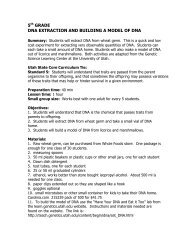1st grade seed germination experiments part ii - Beacon Heights ...
1st grade seed germination experiments part ii - Beacon Heights ...
1st grade seed germination experiments part ii - Beacon Heights ...
You also want an ePaper? Increase the reach of your titles
YUMPU automatically turns print PDFs into web optimized ePapers that Google loves.
1 ST GRADESEED GERMINATION EXPERIMENTS PART IISummary: After <strong>seed</strong>s have germinated and sprouts have grown, studentsevaluate their results from the prior lesson. Experiments will be analyzed toevaluate which conditions of light, water, soil, temperature, and type of soilproduce the longest shoots and roots as well as the healthiest looking plants.Students present their findings to the class.Utah State Core Curriculum Tie:Standard 1: The Processes of Science, Communication of Science, andthe Nature of ScienceObjective 1: Generating EvidenceObjective 2: Communicating scienceObjective 3: Knowing in scienceStandard 4: Life ScienceObjective 2: Living things change and depend upon their environment to satisfytheir basic needs.Indicator: Identify how natural earth materials help to sustain plant life. Makeobservations about living things and their environment using the five senses.Describe and model life cycles of living things.Preparation time: 30 minLesson time: 50 minSmall group size: works best with one adult for every 5 studentsObjectives:1. Students will gather data by measuring the longest roots and shoots of theexperimental plants.2. Students will record the data in a data table.3. Students will analyze the data and decide which conditions they studiedproduced the healthiest plants.4. Students will present their findings to the class.Materials:Plants from prior <strong>germination</strong> experimentRulersData tableGroup sheets and predictions from the earlier lessonBackground information: Found on the previous <strong>seed</strong> <strong>germination</strong>lesson.
Pre-lab discussion: Remind the students of the conditions that were studiedby each of the groups. Tell them that as scientists they are now ready to find outthe results of their experiment. Explain the process of measuring their plants,recording the data, and drawing conclusions. Explain that as scientists theyneed to share their results with their scientific community, which is the rest ofthe class.Instructional procedure: Students will resume with the same groups theywere in on the previous lesson.1. Remind the groups what condition their experiment was testing and whattheir original prediction was.2. Remove <strong>seed</strong>lings and their attached paper towels from the cups. Lay themout on the table. Count how many of the <strong>seed</strong>s germinated and report thefinding on the data sheet. For the soil sample plants (group 5), measure theheight of the shoot above the soil and count how many plants there are for<strong>germination</strong> number.3. Decide what is root and shoot. Usually there is a division of green shoot fromwhite root. Measure several of the longer roots and shoots. Record the longestroot and shoot on the data sheet.4. Evaluate your prediction for its accuracy. Discuss whether your resultssupport your prediction or not. Complete the questions on the data table.5. As a group you are going to report your findings to the class. Have thestudents’ report what their original experiment was, what their results were, andwhether or not they think this data supported or did not support their prediction.Also, discuss any problems your experiment may have had, e.g., didn’t getenough water, planted too many <strong>seed</strong>s, etc. Practice with your group what theyare each going to say and work on reporting to the class skills.
6. As a class, write on the board the conditions that were best for each group of<strong>experiments</strong>. In conclusion, decide what the best conditions are to germinate<strong>seed</strong>s.



